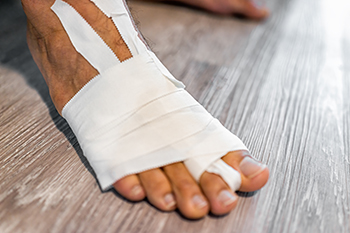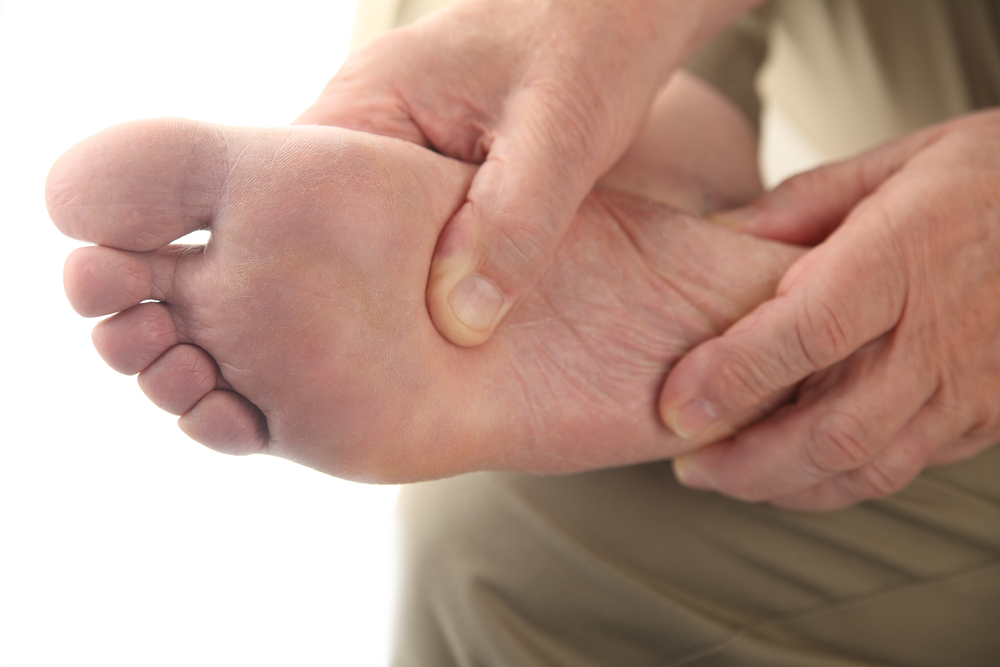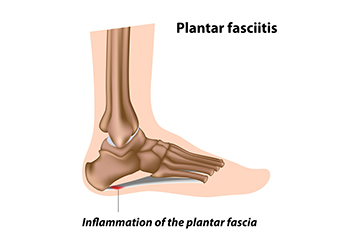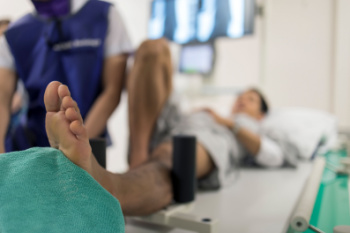Items filtered by date: July 2025
Treatment for Turf Toe Injuries

Turf toe is a sprain of the joint located at the base of the big toe, often caused by forcefully bending the toe upward. Turf toe can result from repeated stress or a sudden movement during sports or other activities that place excess pressure on the front of the foot. Symptoms of turf toe include pain, swelling, stiffness, or a reduced ability to move the big toe. If the injury is severe, walking or bearing weight may become difficult. Turf toe can involve damage to ligaments, tendons, and the soft tissue beneath the big toe. A podiatrist can assess the severity of the injury with a physical exam and imaging studies. Depending on the damage, treatment may include immobilization with a walking boot or, in more severe cases, surgery to repair torn ligaments or joint damage. If you are experiencing symptoms of turf toe, it is suggested that you schedule an appointment with a podiatrist for an exam and appropriate treatment options.
Toe pain can disrupt your daily activities. If you have any concerns, contact one of our podiatrists of New York, NY. Our doctors can provide the care you need to keep you pain-free and on your feet.
What Causes Toe Pain?
Most severe toe pain is caused due to a sports injury, trauma from dropping something heavy on the toe, or bumping into something rigid. Other problems can develop over time for various reasons.
Toe pain can be caused by one or more ailments. The most common include:
- Trauma
- Sports injury
- Wearing shoes that are too tight
- Arthritis
- Gout
- Corns and calluses
- Hammertoe
- Bunions
- Blisters
- Ingrown toenails
- Sprains
- Fractures (broken bones)
- Dislocations
When to See a Podiatrist
- Severe pain
- Persistent pain that lasts more than a week
- Signs of infection
- Continued swelling
- Pain that prevents walking
Diagnosis
In many cases the cause of toe pain is obvious, but in others, a podiatrist may want to use more advanced methods to determine the problem. These can range from simple visual inspections and sensation tests to X-rays and MRI scans. Prior medical history, family medical history, and any recent physical traumatic events will all be taken into consideration for a proper diagnosis.
Treatment
Treatments for toe pain and injuries vary and may include shoe inserts, padding, taping, medicines, injections, and in some cases, surgery. If you believe that you have broken a toe, please see a podiatrist as soon as possible.
If you have any questions please contact our office located in New York, NY . We offer the newest diagnostic and treatment technologies for all your foot and ankle needs.
Pain on the Inner Side of the Foot After a Run

Pain on the inner side of the foot is common in runners and may stem from structural problems, overuse, or injury. One possible cause is flat feet, in which the arches collapse during movement. This causes the foot to roll inward, placing excess strain on the inner arch and the plantar fascia, a band of connective tissue that runs from the heel to the toes. Repeated stress in this area can lead to pain both during and after activity. Another potential cause is inflammation of the posterior tibial tendon, which helps support the arch. In some cases, inner foot pain may indicate a stress fracture in a bone such as the navicular bone, caused by repetitive impact. A podiatrist can evaluate the cause of the pain, recommend proper support, and provide appropriate treatment. If you are experiencing pain in the inner side of the foot, especially after running, it is suggested that you schedule an appointment with a podiatrist for a diagnosis and appropriate treatment.
Foot Pain
Foot pain can be extremely painful and debilitating. If you have a foot pain, consult with one of our podiatrists from New York, NY. Our doctors will assess your condition and provide you with quality foot and ankle treatment.
Causes
Foot pain is a very broad condition that could be caused by one or more ailments. The most common include:
- Bunions
- Hammertoes
- Plantar Fasciitis
- Bone Spurs
- Corns
- Tarsal Tunnel Syndrome
- Ingrown Toenails
- Arthritis (such as Gout, Rheumatoid, and Osteoarthritis)
- Flat Feet
- Injury (from stress fractures, broken toe, foot, ankle, Achilles tendon ruptures, and sprains)
- And more
Diagnosis
To figure out the cause of foot pain, podiatrists utilize several different methods. This can range from simple visual inspections and sensation tests to X-rays and MRI scans. Prior medical history, family medical history, and any recent physical traumatic events will all be taken into consideration for a proper diagnosis.
Treatment
Treatment depends upon the cause of the foot pain. Whether it is resting, staying off the foot, or having surgery; podiatrists have a number of treatment options available for foot pain.
If you have any questions, please feel free to contact our office located in New York, NY . We offer the newest diagnostic and treatment technologies for all your foot care needs.
Plantar Fasciitis and Heel Spur Syndrome

Plantar fasciitis, also known as heel spur syndrome, is a common cause of heel pain. It occurs when the thick band of tissue along the bottom of the foot becomes inflamed, often where it connects to the heel bone. Signs include sharp pain when taking the first steps in the morning or after long periods of rest. Causes include overuse, wearing poor footwear, or standing for long hours. Risk factors include flat feet, high arches, and obesity. A podiatrist can diagnose the condition and provide treatments such as stretching plans or custom orthotics. If you have consistent heel pain, it is suggested that you visit a who can provide appropriate relief and treatment solutions.
Plantar fasciitis can be very painful and inconvenient. If you are experiencing heel pain or symptoms of plantar fasciitis, contact one of our podiatrists from New York, NY. Our doctors can provide the care you need to keep you pain-free and on your feet.
What Is Plantar Fasciitis?
Plantar fasciitis is the inflammation of the thick band of tissue that runs along the bottom of your foot, known as the plantar fascia, and causes mild to severe heel pain.
What Causes Plantar Fasciitis?
- Excessive running
- Non-supportive shoes
- Overpronation
- Repeated stretching and tearing of the plantar fascia
How Can It Be Treated?
- Conservative measures – anti-inflammatories, ice packs, stretching exercises, physical therapy, orthotic devices
- Shockwave therapy – sound waves are sent to the affected area to facilitate healing and are usually used for chronic cases of plantar fasciitis
- Surgery – usually only used as a last resort when all else fails. The plantar fascia can be surgically detached from the heel
While very treatable, plantar fasciitis is definitely not something that should be ignored. Especially in severe cases, speaking to your doctor right away is highly recommended to avoid complications and severe heel pain. Your podiatrist can work with you to provide the appropriate treatment options tailored to your condition.
If you have any questions, please feel free to contact our office located in New York, NY . We offer the newest diagnostic and treatment technologies for all your foot care needs.
Recognizing Metatarsal Stress Fractures

A metatarsal stress fracture is a small crack in one of the long bones of the foot, caused by repetitive pressure or overuse. Common in athletes, dancers, and individuals who increase activity levels quickly, this injury often develops gradually. Symptoms include localized pain that worsens with weight-bearing, swelling, and tenderness over the affected bone. Risk factors include poor footwear, sudden changes in activity or intensity, weak bones, and biomechanical issues. A podiatrist can diagnose the fracture using imaging and physical exams and will guide recovery through rest, protective footwear, or activity modification. If you have foot pain that increases with movement, it is suggested that you promptly visit a podiatrist who can accurately diagnose the problem and provide treatment..
Activities where too much pressure is put on the feet can cause stress fractures. To learn more, contact one of our podiatrists from New York, NY. Our doctors can provide the care you need to keep your pain free and on your feet.
Dealing with Stress Fractures of the Foot and Ankle
Stress fractures occur in the foot and ankle when muscles in these areas weaken from too much or too little use. The feet and ankles then lose support when walking or running from the impact of the ground. Since there is no protection, the bones receive the full impact of each step. Stress on the feet can cause cracks to form in the bones, thus creating stress fractures.
What Are Stress Fractures?
Stress fractures occur frequently in individuals whose daily activities cause great impact on the feet and ankles. Stress factors are most common among:
- Runners
- People affected with Osteoporosis
- Tennis or basketball players
- Gymnasts
- High impact workouts
Symptoms
Pain from the fractures occur in the area of the fractures and can be constant or intermittent. It will often cause sharp or dull pain with swelling and tenderness. Engaging in any kind of activity which involves high impact will aggravate pain.
If you have any questions please contact our office located in New York, NY . We offer the newest diagnostic and treatment technologies for all your foot and ankle needs.
Plantar Warts Can Be Treated!
Common Conditions Treated by a Podiatrist

A podiatrist specializes in diagnosing and treating a wide range of foot and ankle conditions. This type of doctor can manage fractures and sprains resulting from injuries, helping restore stability and function. Hammertoes and bunions are common deformities that can cause pain and limit mobility, which a podiatrist can address with both conservative and surgical options. People with diabetes often face serious foot issues like ulcers and infections, requiring expert care to prevent complications. Arthritis in the feet can lead to stiffness and discomfort, and a podiatrist can provide relief through personalized treatment plans. If you have foot or ankle pain, it is suggested that you schedule an appointment with a podiatrist to receive specialized care tailored to your needs and improve your overall foot health.
If you are experiencing pain in the feet or ankles, don’t join the stubborn majority refusing treatment. Feel free to contact one of our podiatrists from New York, NY. Our doctors can provide the care you need to keep you pain-free and on your feet.
What Is a Podiatrist?
Someone would seek the care of a podiatrist if they have suffered a foot injury or have common foot ailments such as heal spurs, bunions, arch problems, deformities, ingrown toenails, corns, foot and ankle problems, etc.
Podiatric Treatment
A podiatrist will treat the problematic areas of the feet, ankle or lower leg by prescribing the following:
- Physical therapy
- Drugs
- Orthotic inserts or soles
- Surgery on lower extremity fractures
A common podiatric procedure a podiatrist will use is a scanner or force plate which will allow the podiatrist to know the designs of orthotics. Patients are then told to follow a series of tasks to complete the treatment. The computer will scan the foot a see which areas show weight distribution and pressure points. The podiatrist will read the analysis and then determine which treatment plans are available.
If you have any questions, please feel free to contact our office located in New York, NY . We offer the newest diagnostic and treatment technologies for all your foot care needs.


